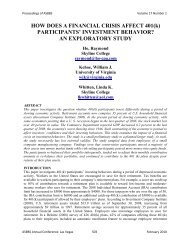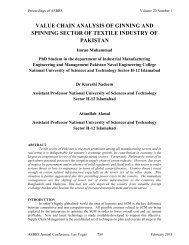stock repurchase announcements: a test of market ... - Asbbs.org
stock repurchase announcements: a test of market ... - Asbbs.org
stock repurchase announcements: a test of market ... - Asbbs.org
You also want an ePaper? Increase the reach of your titles
YUMPU automatically turns print PDFs into web optimized ePapers that Google loves.
Importance <strong>of</strong> Geographic Space and Location<br />
Southland”. SCAG’s plan has been presented as the ‘most ambitious growth visioning effort in<br />
California’ (SCAG, 2004). Unfortunately, the major part <strong>of</strong> the project is still deeply rooted in<br />
the traditional transportation planning and, as a result, the SCAG’s plan recommends growth<br />
patterns that rely heavily on the existing transportation networks and infrastructure. The old<br />
stereotype <strong>of</strong> ‘if we build it they will come’ tends to dominate the main philosophy behind the<br />
key initiatives. SCAG fails to identify comparative and competitive advantages <strong>of</strong> the region and<br />
it provides very little information on the type <strong>of</strong> businesses it wants to see in the region. It gives<br />
almost no attention to economic spaces <strong>of</strong> current and future industries.<br />
The San Diego Association <strong>of</strong> Governments (SANDAG) may in some ways represent a more<br />
progressive approach. SANDAG’s strategy appears to take advantage <strong>of</strong> the basic cluster concept<br />
and identifies 16 most important clusters within the greater San Diego economy (SANDAG, 2001<br />
& 2004). The plan also recognizes the importance <strong>of</strong> exports to the regional economy, but it<br />
stops short <strong>of</strong> identifying potential opportunities in foreign <strong>market</strong>s. SANDAG uses the term<br />
‘employment clusters’ rather than ‘industry clusters’, which is misleading as it tends to change<br />
the focus <strong>of</strong> the cluster theory from the production side to employment. In addition some <strong>of</strong> the<br />
identified clusters are questionable in terms <strong>of</strong> their role in the regional economy. For example,<br />
the ‘fruits and vegetables’ and ‘horticulture’ are identified as two separate clusters while the<br />
higher education, which is extremely important to San Diego’s economy is basically excluded as<br />
not meeting the rigid standards <strong>of</strong> SANDAG’s cluster. Another questionable cluster entry is the<br />
‘uniformed military’, which is not even concentrated in one area <strong>of</strong> the county but scattered<br />
throughout the region. SANDAG’s definitions appear to confuse geographic and economic<br />
spaces. They are <strong>of</strong>ten too subjective and seem to be influenced by political factors. SANDAG’s<br />
regional development approach still requires a lot more work and its recommendations are not<br />
free <strong>of</strong> controversy. SANDAG’s case may also prove that the reliance on the concept <strong>of</strong> industry<br />
clusters alone does not address all regional development needs and challenges.<br />
FUTURE OF REGIONAL INITIATIVES AND CLUSTERS<br />
Despite serious challenges facing individual regions, there are new hopes and expectations as<br />
more progress is made in understanding the role <strong>of</strong> geographic space in regional economic<br />
development. A good example <strong>of</strong> a new project in Southern California may prove to be the<br />
Green Valley Initiative (GVI), which relies on a different approach than those adopted by SCAG<br />
and SANDAG. The 2007 GVI program outline tries to incorporate multiple stakeholders,<br />
including businesses, public agencies, academic institutions and environmental groups from<br />
Riverside and San Bernardino counties and gives all participants equal voice in regional planning<br />
(GVI, 2007). However, it is too early to judge what theoretical concepts will be used in the future<br />
and whether this new initiative with ambitious goals and an emphasis on sustainable development<br />
will be able to live up to its own high standards and expectations, and especially whether GVI<br />
will succeed in fully integrating economic and geographic spaces.<br />
There is no question that more theoretical work will be required in the future as well to support<br />
regional development initiatives. A recent study commissioned by the U.S. Department <strong>of</strong><br />
Commerce suggests a need for developing the “Regionalism-Industrial-Cluster focused<br />
curriculum” to assist public <strong>of</strong>ficials involved in economic development. The report based on the<br />
existing experiences shows some common purpose in regional development, but also a variety <strong>of</strong><br />
priorities, opinions and approaches used by practitioners when trying to address regional<br />
challenges. According to the survey conducted by the authors close to 40% <strong>of</strong> public agencies<br />
involved in regional development have conducted or commissioned a study on industry clusters<br />
within their region and some even claim using detailed cluster based strategies (U.S. Dept. <strong>of</strong><br />
ASBBS E-Journal, Volume 4, No.1, 2008 189

















